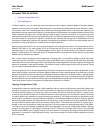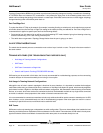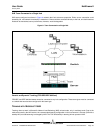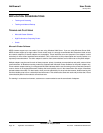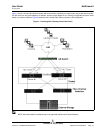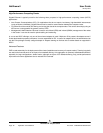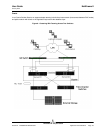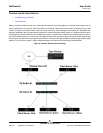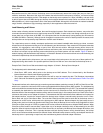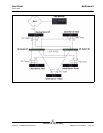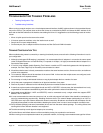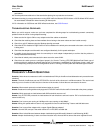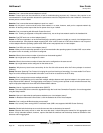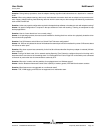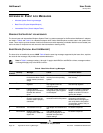
User Guide NetXtreme II
January 2010
Broadcom Corporation
Document ENGSRVT52-CDUM100-R Application Considerations Page 51
Because there are four client servers, the backup server can simultaneously stream four backup jobs (one per client) to a
multidrive autoloader. Because of the single link between the switch and the backup server; however, a 4-stream backup
can easily saturate the adapter and link. If the adapter on the backup server operates at 1 Gbps (125 MB/s), and each client
is able to stream data at 20 MB/s during tape backup, the throughput between the backup server and switch will be at 80
MB/s (20 MB/s x 4), which is equivalent to 64% of the network bandwidth. Although this is well within the network bandwidth
range, the 64% constitutes a high percentage, especially if other applications share the same link.
Load Balancing and Failover
As the number of backup streams increases, the overall throughput increases. Each data stream, however, may not be able
to maintain the same performance as a single backup stream of 25 MB/s. In other words, even though a backup server can
stream data from a single client at 25 MB/s, it is not expected that four simultaneously-running backup jobs will stream at
100 MB/s (25 MB/s x 4 streams). Although overall throughput increases as the number of backup streams increases, each
backup stream can be impacted by tape software or network stack limitations.
For a tape backup server to reliably use adapter performance and network bandwidth when backing up clients, a network
infrastructure must implement teaming such as load balancing and fault tolerance. Data centers will incorporate redundant
switches, link aggregation, and trunking as part of their fault tolerant solution. Although teaming device drivers will
manipulate the way data flows through teamed interfaces and failover paths, this is transparent to tape backup applications
and does not interrupt any tape backup process when backing up remote systems over the network. Figure 10 shows a
network topology that demonstrates tape backup in a Broadcom teamed environment and how smart load balancing can
load balance
tape backup data across teamed adapters.
There are four paths that the client-server can use to send data to the backup server, but only one of these paths will be
designated during data transfer. One possible path that Client-Server Red can use to send data to the backup server is:
Example Path: Client-Server Red sends data through Adapter A, Switch 1, Backup Server Adapter A.
The designated path is determined by two factors:
• Client-Server ARP cache; which points to the backup server MAC address. This is determined by the Broadcom
intermediate driver inbound load balancing algorithm.
• The physical adapter interface on Client-Server Red will be used to transmit the data. The Broadcom intermediate
driver outbound load balancing algorithm determines this (see Outbound Traffic Flow and Inbound Traffic Flow (SLB
Only).
The teamed interface on the backup server transmits a gratuitous address resolution protocol (G-ARP) to Client-Server Red,
which in turn, causes the client server ARP cache to get updated with the Backup Server MAC address. The load balancing
mechanism within the teamed interface determines the MAC address embedded in the G-ARP. The selected MAC address
is essentially the destination for data transfer from the client server.On Client-Server Red, the SLB teaming algorithm will
determine which of the two adapter interfaces will be used to transmit data. In this example, data from Client Server Red is
received on the backup server Adapter A interface. To demonstrate the SLB mechanisms when additional load is placed on
the teamed interface, consider the scenario when the backup server initiates a second backup operation: one to Client-
Server Red, and one to Client-Server Blue. The route that Client-Server Blue uses to send data to the backup server is
dependant on its ARP cache, which points to the backup server MAC address. Because Adapter A of the backup server is
already under load from its backup operation with Client-Sever Red, the Backup Server invokes its SLB algorithm to
inform
Client-Server Blue (through an G-ARP) to update its ARP cache to reflect the backup server Adapter B MAC address. When
Client-Server Blue needs to transmit data, it uses either one of its adapter interfaces, which is determined by its own SLB
algorithm. What is important is that data from Client-Server Blue is received by the Backup Server Adapter B interface, and
not by its Adapter A interface. This is important because with both backup streams running simultaneously, the backup
server must
load balance
data streams from different clients. With both backup streams running, each adapter interface on
the backup server is processing an equal load, thus load-balancing data across both adapter interfaces.



